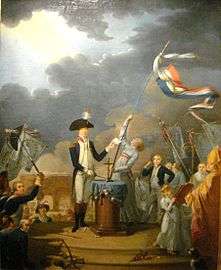Georges Washington de La Fayette


Georges Washington Louis Gilbert de La Fayette (1779–1849) was the son of Gilbert du Motier, Marquis de La Fayette, the French officer and hero of the American Revolution, and Adrienne de La Fayette.
The elder La Fayette named his son in honor of George Washington, under whom he served in the Revolutionary War.[2]
Life
From 1783, La Fayette grew up in the Hôtel de La Fayette at 183 rue de Bourbon, Paris. Their home was the headquarters of Americans in Paris.
People such as Benjamin Franklin, Mr. and Mrs. John Jay, and Mr. and Mrs. John Adams[3] met there every Monday. They dined with the La Fayette family as well as with the liberal nobility, such as Clermont-Tonnerre, Madame de Staël, Morellet, and Marmontel.
Reign of Terror
In 1789, the French Revolution began. After 10 September 1792, in the wake of the September Massacres, La Fayette went into hiding with his tutor, Felix Frestrel. His mother was put under house arrest and, later, in prison. On 22 July 1794, his great-grandmother, Catherine de Cossé-Brissac, duchesse de Noailles, his grandmother, Henriette-Anne-Louise d'Aguesseau, duchesse d'Ayen, and aunt, Anne Jeanne Baptiste Louise, vicomtesse d'Ayen, were guillotined.[4]
In April 1795, Georges was sent to America with Frestrel.[5] While there, he studied at Harvard, and he was a house guest of George Washington at the presidential mansion in Philadelphia, Pennsylvania, and at the Washington family home, Mount Vernon, Virginia.
On 15 October 1795, Georges' mother was sent to join his father and his sisters, Anastasie and Virginie, in the prison fortress of Olmütz. All of their money and baggage were confiscated.[6] On 18 September 1797, the family was released under the terms of the treaty of Campo-Formio (18 October 1797). They recuperated at Lehmkuhlen, Holstein, near his aunt Madame de Montagu and great-aunt Madame de Tessé.
In 1798, Georges returned from America. In 1799, the family moved to Vianen, near Utrecht during the brief time it was the Batavian Republic.[7] Since Georges was turned back at the French border as an exile, he stayed behind with his father, while his mother Adrienne returned to France. After Napoleon's plebiscite, on 1 March 1800, he restored La Fayette's citizenship, and removed their names from the émigrés list.
Army service
Georges entered the army and was wounded at the Battle of Mincio in 1800. Later, he was aide-de-camp to General Grouchy at the Battle of Eylau, 1807, where he gave up his horse, after Grouchy's had been killed, at the risk of his own life.[8] Napoleon's distrust of Georges' father's independence rendered promotion improbable, and Georges de La Fayette retired into private life in 1807.
Restoration
He entered the Chamber of Deputies and voted consistently on the Liberal side. He was away from Paris during the revolution of July 1830, but he took an active part in the Campagne des banquets, which led up to the French Revolution of 1848.[9]
La Fayette's visit to America
Georges accompanied his father on the latter's triumphant visit to America in 1824 and 1825. Throughout most of the long tour, he kept close company with his father's secretary, Auguste Levasseur.[10] They observed a volunteer fire company turnout in New York City.[11]
He met George Washington Parke Custis at Arlington House. He visited Mount Vernon,[12] and he met Thomas Jefferson at Monticello.[13]
Family
Georges Washington de Lafayette married Emilie de Tracy, daughter of the Comte de Tracy, in 1802; they had three daughters and two sons.
Sons:
- Oscar Thomas Gilbert Motier de La Fayette (1815–1881) was educated at the École Polytechnique and served as an artillery officer in Algeria. He entered the Chamber of Deputies in 1846 and voted, like his father, with the extreme Left. After the revolution of 1848, he received a post in the provisional government; as a member of the Constituent Assembly, he became secretary of the war committee. After the dissolution of the Legislative Assembly in 1851, he retired from public life, but emerged on the establishment of the third republic, becoming a life senator in 1875.[9]
- Edmond Motier de La Fayette (1818–1890) shared his brother's political opinions; Edmond was one of the secretaries of the Constituent Assembly and a member of the senate from 1876 to 1888.[9]
Daughters:
- Natalie, who married Adolphe Périer, a banker and nephew of Casimir Pierre Périer.
- Matilde, who married Maurice de Pusy (1799–1864, son of Jean-Xavier Bureau de Pusy).
- Clementine, who married Gustave de Beaumont.[14]
Legacy
The appearance of the young Georges Washington is known from a painting, The oath of La Fayette at the Fête de la Fédération, 14 July 1790, in which he is standing on the right alongside his father.[1] The painting is on display at the Musée Carnavalet.
See also
- Franco-American alliance
- La Fayette family
- President's House (Philadelphia) — third Presidential mansion
Notes
- ↑ Marquis de La Fayette Gregory Payan, Alice B. McGinty p.51
- ↑ ib. Maurois, André, p.113
- ↑ Elizabeth Wormeley Latimer, Thomas Waters Griffith, My Scrap-book of the French Revolution, p.393
- ↑ David A. Clary. Adopted Son. pp. 411, 421.
- ↑ Unger, Harlow Giles (2002). Lafayette. John Wiley & Sons. p. 309. ISBN 0-471-39432-7.
- ↑ Edith Helen Sichel, The Household of the Lafayettes, p. 260
- ↑ Grouchy correspondence with his wife, Emmanuel Grouchy à Eylau
- 1 2 3 "LA FAYETTE, MARIE JOSEPH PAUL YVES ROCH GILBERT DU MOTIER, Marquis de (1757–1834)", Encyclopædia Britannica, 1911
- ↑ Levasseur, Auguste (1929). Lafayette in America in 1824 and 1825. New York: Gallaher & White. pp. 211–12.
- ↑ Auguste Levasseur. Lafayette in America. Translator Alan Hoffman. p. 16.
- ↑ Auguste Levasseur. Lafayette in America. Translator Alan Hoffman. p. 197.
- ↑ Auguste Levasseur. Lafayette in America. Translator Alan Hoffman. p. 234.
- ↑ Jules Cloquet, Isaiah Townsend (1835). Recollections of the Private Life of General Lafayette. Google. p. 227. Retrieved 22 February 2011.